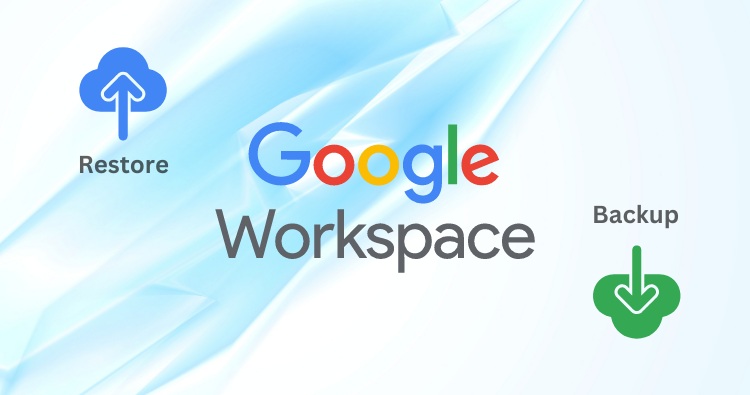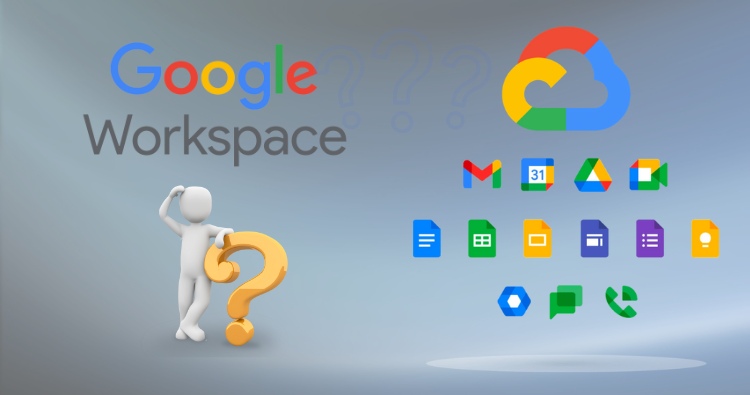Google Workspace (formerly known as G Suite) is a collection of cloud-based productivity and collaboration tools developed by Google. It includes a variety of applications that can be used for communication, collaboration, and file management in businesses, schools, and other organizations.
Some of the main features and tools included in Google Workspace are:
- Gmail: A professional email service that allows users to send and receive emails, schedule appointments, and organize their inboxes.
- Calendar: A tool for scheduling and organizing events and appointments for personnel and professionals.
- Drive: A cloud storage service that allows users to store, share, and collaborate on documents, spreadsheets, presentations, and other files.
- Docs: A word-processing application that allows users to create, edit, and collaborate on documents in real time.
- Sheets: A spreadsheet application that allows users to create, edit, and collaborate on spreadsheets.
- Slides: A presentation application that allows users to create, edit, and collaborate on presentations.
- Meet: A video conferencing and collaboration tool that allows users to connect with each other remotely.
Google Workspace is designed to help teams and organizations work together more efficiently by providing a range of tools that allow for easy communication, collaboration, and file sharing. It is commonly used by businesses, schools, and other organizations as a way to streamline their operations and improve productivity.
Read more: What is Google Workspace?
So, What Is Google Workspace Used For in Business?
Google Workspace is commonly used by businesses to improve communication and collaboration among employees and streamline various business operations. Some specific ways that businesses use Google Workspace include:
- Email communication: Gmail, the email service included in Google Workspace, is used by many businesses as a professional email platform. It allows employees to send and receive emails, schedule appointments, and organize their inboxes.
- Scheduling and calendar management: Businesses often use the Calendar application in Google Workspace to schedule and organize meetings, events, and appointments. It can also be used to manage employee schedules and track time off.
- File storage and collaboration: Google Drive, the cloud storage service included in Google Workspace, is used by businesses to store and share documents, spreadsheets, presentations, and other files. The collaboration tools included in Google Workspace, such as Google Docs, Sheets, and Slides, allow employees to work on these files together in real-time, regardless of their location.
- Video conferencing and meetings: The Meet application in Google Workspace is commonly used by businesses to hold video meetings and conferences with employees, clients, and partners. It allows users to connect with each other remotely, share screens, and collaborate on documents in real-time.
Overall, Google Workspace is used by businesses as a way to improve communication, collaboration, and productivity among employees, as well as to streamline various business operations.
How Businesses Benefit From Google’s Integrated Tools
Google Workspace offers a range of integrated tools that can benefit businesses in several ways:
- Improved communication and collaboration: Using Google Workspace, businesses can easily communicate and collaborate with employees, clients, and partners, regardless of location. The email, calendar, and video conferencing tools included in Google Workspace allow for seamless communication and collaboration. In contrast, the file storage and collaboration tools allow for easy sharing and co-editing of documents and other files.
- Enhanced productivity: Google Workspace provides a range of tools that can help businesses streamline their operations and improve productivity. For example, the calendar and email tools allow employees to better organize and manage their time. In contrast, the file storage and collaboration tools allow easy access to and sharing important documents and information.
- Reduced IT costs: By using Google Workspace, businesses can reduce their IT costs by eliminating the need to purchase and maintain on-premises software and hardware. The cloud-based nature of Google Workspace means businesses only pay for the services they use and can easily scale up or down as needed.
- Enhanced security: Google Workspace includes various security features designed to protect businesses’ data and keep it private. These features include data encryption, two-factor authentication, and the ability to set permissions and controls on who has access to what data.
By using Google Workspace, businesses can benefit from improved communication and collaboration, enhanced productivity, reduced IT costs and enhanced security.
Why These Work for Many Businesses
There are several reasons why Google Workspace is a good fit for many businesses:
- Ease of use: Google Workspace is designed to be easy to use, with intuitive interfaces and straightforward tools. This means that employees can quickly get up to speed on using the various applications without extensive training.
- Wide range of tools: Google Workspace offers a wide range of tools that can be used for various business needs, from communication and collaboration to file storage and management. This means businesses can get all the tools they need in one place rather than using multiple separate applications.
- Scalability: Google Workspace is designed to be scalable, which means that businesses can easily add or remove users and services as needed. This makes it a good fit for growing or changing businesses, as they can easily adapt their usage of Google Workspace to match their needs.
- Security: Google Workspace includes various security features to protect businesses’ data and keep it private. This is important for businesses that handle sensitive information or comply with various data protection regulations.
- Cost-effective: Google Workspace is generally considered cost-effective, as businesses only pay for the services they use. This can be especially appealing to small and medium-sized businesses, which may not have the budget to invest in expensive on-premises software and hardware.
Overall, Google Workspace is a good fit for many businesses because it is easy to use, offers a wide range of tools, is scalable, has strong security measures, and is cost-effective.
How Workspace Improves Team Collaboration?
Google Workspace includes a range of tools and features that can help improve team collaboration:
- Real-time collaboration: The collaboration tools included in Google Workspace, such as Google Docs, Sheets, and Slides, allow teams to work on documents and other files together in real-time, regardless of their location. This means that team members can collaborate on projects, share ideas, and edit documents without being physically present in the same location.
- File sharing: Google Drive, the cloud storage service included in Google Workspace, allows teams to store and share documents, spreadsheets, presentations, and other files. This means that team members can easily access and share the files they need to work on, regardless of where they are located.
- Video conferencing: The Meet application in Google Workspace allows teams to hold video meetings and conferences with each other and clients and partners. This can be especially useful for teams that are working remotely or for teams that are located in different parts of the world.
- Chat and messaging: Google Workspace includes chat and messaging tools, such as Google Chat and Hangouts, that allow team members to communicate and collaborate in real-time. These tools can be used to share ideas, ask questions, and get feedback from colleagues.
Overall, Google Workspace can help improve team collaboration by providing a range of tools and features that allow teams to communicate and collaborate with each other in real-time, regardless of their location.
Google Workspace Helping Real Companies (examples)
Google Workspace is used by many businesses, schools, and other organizations to improve communication, collaboration, and productivity. Here are a few examples of how Google Workspace has helped real companies:
- Salesforce: Salesforce, a customer relationship management (CRM) software company, uses Google Workspace to improve employee communication and collaboration. The company has implemented Google Meet, a video conferencing tool, to hold meetings and conferences with employees and clients, and Google Drive, a cloud storage service, to store and share documents and other files.
- Accenture: Accenture, a professional services company, has implemented Google Workspace to improve employee communication and collaboration. The company uses Google Meet, a video conferencing tool, to hold meetings and conferences with employees and clients, and Google Drive, a cloud storage service, to store and share documents and other files.
- ASOS: ASOS, an online fashion retailer, uses Google Workspace to improve employee communication and collaboration. The company uses Google Meet, a video conferencing tool, to hold meetings and conferences with employees and clients, and Google Drive, a cloud storage service, to store and share documents and other files.
These examples show how many businesses use Google Workspace to improve communication, collaboration, and productivity.
Read more: How to Backup and Restore Google Workspace?
How does Google Workspace compare To Other Options?
Google Workspace is one of several options available for cloud-based productivity and collaboration tools. Some of the other options include:
- Microsoft 365: Microsoft 365 is a cloud-based productivity and collaboration suite developed by Microsoft. It includes various tools, such as email, calendar, file storage, and collaboration tools, similar to Google Workspace.
- Zoho Workplace: Zoho Workplace is a cloud-based productivity and collaboration suite developed by Zoho. It includes various tools, such as email, calendar, file storage, and collaboration tools, similar to Google Workspace.
- Slack: Slack is a cloud-based collaboration platform that allows teams to communicate and collaborate in real-time. It includes features such as chat and messaging, file sharing, and integrations with other tools and services.
When comparing Google Workspace to these other options, it is important to consider the specific needs of your business and which suite of tools is the best fit. Some factors to consider include the range of tools offered, the ease of use, the level of integration with other tools and services, and the cost. It may also be helpful to try out the different options with a free trial to see which one works best for your team.
Read more: Google Workspace Free Alternatives
What’s The Right Choice To Help Your Business?
The right choice for your business will depend on your specific needs and priorities. Here are a few factors to consider when deciding which productivity and collaboration suite is the best fit for your business:
- Range of tools: Consider which tools your business needs to be successful and whether the suite you are considering offers those tools. For example, if you need email, calendar, file storage, and collaboration tools, you may want to consider a suite like Google Workspace or Microsoft 365.
- Ease of use: Consider whether the suite you are considering is easy for your team to use and learn. This can be especially important if you have team members who are not particularly tech-savvy.
- Integration with other tools: Consider whether the suite you are considering integrates well with your business’s other tools and services. This can help to streamline your workflows and improve productivity.
- Cost: Consider the cost of the suite you are considering, including any ongoing subscription fees. Make sure to compare the costs of different options and consider whether the benefits offered by the suite justify the cost.
Overall, the right choice for your business will depend on your specific needs and priorities. It may be helpful to try out different options with a free trial to see which one works best for your team.




